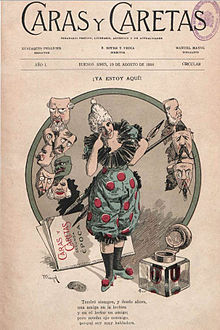Wifag machine factory
Winkler, Fallert & Cie. (officially WIFAG since 1971 ) was a machine factory based in Bern from 1904 to 2009 .
history
Foundation and first years
In 1904 Karl Emil Winkler , Otto Wagner and Fritz Philipp Fallert founded a limited partnership under the name "Winkler, Fallert und Cie." To operate a machine shop and a machine shop . based in Bern.
Initially, the company concentrated on the sale of printing machines of foreign origin in Switzerland and abroad. Business was good, so Winkler decided to develop and manufacture its own machines. The company successfully applied for a contract from the Argentine publisher of Caras y Caretas , a weekly literary magazine in Buenos Aires . "Winkler, Fallert and Cie." supplied a stereotype machine and a device for collating and gluing the cover sheets. After this success, the company further developed the stereotype machines, thanks to which printing plates could be produced faster, more economically and in better quality than with traditional methods.
The upswing of the company brought with it the need for spatial expansion, which is why the "Winkler, Fallert und Cie." In 1912 he moved into an office and factory building for around 100 employees on Bern's Wylerfeld.
First World War and the interwar period
When trade in third-party machines collapsed during the First World War , "Winkler, Fallert und Cie." on the serial production and sale of their own machines. At the end of the war, sales of in-house products exceeded that of third-party machines for the first time. The products were mainly sold domestically, but also delivered to the countries of both warring parties, to Germany, France, Italy and Holland, because the countries of the Entente no longer ordered German machines.
In 1919 it was converted into a stock corporation . From the 1920s onwards, the company responded to requests for rotary machines by producing individual designs on customer request. The company acquired the knowledge necessary for this, among other things, through the arrival of German mechanical engineers .
While the company was able to expand its business activities during the First World War, the crisis of the post-war period hit it hard. In order to cushion the financial burden, the sales company “International Equipment Company for Graphic Art AG” was founded in 1926 together with the Miehle Company in Chicago , which from 1943 was called Graphicart for short . For cost reasons, from now on the sale was carried out exclusively by this company, «Winkler, Fallert und Cie. AG »focused on production.
Years of war and crisis
After Karl Emil Winkler left the company in 1933 due to differences in management, the company fell into a crisis. However, Otto Wirz (1890–1976) and Karl Bretscher (1885–1966) succeeded in forming a takeover consortium from which the company was taken over in the middle of World War II . The missing orders from abroad due to the war were replaced on the one hand by work for the Swiss machine tool industry and on the other hand by the manufacture of tube printing machines. This enabled the company to consolidate until the end of the war. Thanks to increasing sales, debts could be reduced and operations modernized.
post war period
In the 1950s, the production of machine tools declined, while the manufacture of machines for printing packaging material, for paper and film processing and the manufacture of rotary machines increased again. In 1960, the subsidiary Bageter AG , which had been integrated into the company in 1955, bought the Freiburg manufacturing and trading company Polytype. From now on, the areas of stereotype and typesetting machine magazines, round body printing and foil finishing were located in Freiburg. In Bern, the focus was on building rotary machines.
Concentration and expansion
After Otto Wirz's death in 1976, his daughter Ursula Wirz became Vice President and in 1989 President of the Board of Directors. While WIFAG - as the company was officially called since 1971 - was still doing research in all branches - letterpress, gravure and offset - in the 1970s, in the coming decade it decided to concentrate on offset printing for reasons of cost and capacity . The main focus was now on the construction of double-width, two-cut newspaper offset presses. In 1992 the WIFAG Group, which also included Polytype in Freiburg, the Drent machine factory, Polytype America Corporation PAC in the USA, Prandi in Italy and the WIFAG trading companies in Holland, Germany and Belgium, employed 2115 people worldwide. After Ursula Wirz's death in 2007, the Ursula Wirz Foundation became the main shareholder of WIFAG, which was converted into WIFAG Polytype Holding in the same year .
The End
As a result of the economic crisis that began in 2008 and the ongoing structural crisis on the newspaper market, the construction of printing machines was discontinued in 2009. Since 2011, WIFAG has only existed as a service company that continues to look after the machines delivered within the WIFAG-Polytype-Holding .
archive
- Company archive WIFAG Maschinenfabrik AG in the catalog of the Bern Burger Library
literature
- Andrea Schüpbach: Well printed. Leading minds at the WIFAG machine factory . In: Association for economic history studies (ed.): Swiss pioneers of economy and technology . tape 180 . Zurich 2017, ISBN 978-3-909059-71-3 , p. 112 .
- Machine factory Winkler, Fallert & Cie. Corporation . Les Archives Contemporaines, Geneva 1933.
- Wifag machine factory. Top-class printing systems . In: Roland Cicurel, Liliane Manacassola (Eds.): The Swiss Economy 1219-1991. History in three acts . St. Sulpice 1991, p. 418 f .
Individual evidence
- ↑ City map from 1914
- ↑ a b c d Andrea Schüpbach: Well printed. Leading minds at the WIFAG machine factory . In: Association for economic history studies (ed.): Swiss pioneers of economy and technology . tape 180 . Zurich 2017, ISBN 978-3-909059-71-3 , p. 112 .

